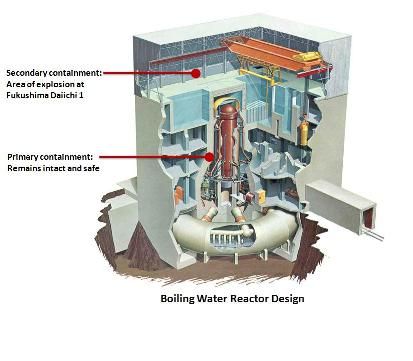Second chances: Containment of a reactor meltdown
By Frank von Hippel | March 14, 2011

One aspect of the drama that we have been witnessing at Japan’s Fukushima Nuclear Power Plants since the March 11 earthquake and tsunami is the efforts of Tokyo Electric Power (TEPCO) to prevent the over-pressurization of the containments of its boiling water reactors at plants I and II. These reactors lost power from the grid due to the earthquake and their backup emergency diesel generators failed, apparently due to damage from the tsunami.
As a result, there was no power for pumping outside water through the heat exchangers used to remove the heat generated by the residual radioactivity in the fuel. The pressure in the reactors therefore began to rise and their pressure-relief valves were opened to relieve this pressure. The reactor containments did have backup pressure-suppression pools of water in their basements and steam-powered pumps that could circulate water from the pools to the reactors. After some time, however, the pressure suppression pools began to boil and were no longer useable for cooling.
In three of the reactors (Fukushima-Daiichi units numbers 1, 2, and 3 — the units that were operating at the time of the earthquake and therefore hot) the water levels in the reactors fell, uncovering their fuel, which overheated and released some of its reactivity into the containment. The steam pressure also built up in the containments to the point where they were on the verge of bursting.
TEPCO therefore received permission from Japan’s government to release some of the gas from the containments. Because this gas contained radioactivity, the surrounding population was evacuated out to a distance of 20 kilometers (12 miles). Fortunately, the release was orders of magnitude smaller than occurred at Chernobyl. Much of the radioactivity is still trapped in the fuel and most what was released probably dissolved in the water. Most importantly, the wind blew the plume to sea.
As a result of the overheating of the reactor fuel, its zirconium cladding reacted with the steam to oxidize the zirconium and release hydrogen from the steam. The hydrogen didn’t explode in the containments because they had been “inerted” by being filled with pure nitrogen (i.e. no oxygen) but, when the hydrogen was vented into the outer containment buildings, it mixed with the air there and exploded, blowing the roofs off the outer buildings but (except perhaps for unit number two) leaving the inner containments and massive spent fuel pools intact.
In 1979, during the accident at reactor number two at Three Mile Island, the fuel was similarly partially uncovered and its fuel cladding failed, releasing a great deal of radioactivity to the containment atmosphere, and there was a hydrogen explosion. But the containment was not over-pressured and no significant amount of radioactivity was released to the atmosphere. The main difference was that electricity was available to power the reactor’s containment cooling systems and condense the steam within it. If the power had failed, the containment of reactor number two would have been over-pressured as well.
The problem of containment over-pressurization and the potential need to vent has been a long-term issue in the nuclear reactor safety community. In 1977, a group of nuclear engineers at the University of California suggested that a robust filtration system be installed in reactors to remove the radioactivity from the vented gases. Some countries picked up the idea. Sweden installed a filtered vent system at the Barseback reactors (subsequently shutdown) across the strait from Copenhagen and France installed filtered vent systems at all of its reactors, which interested both Germany and Japan.
In 1982, after the accident at Three Mile Island, Jan Beyea and I wrote an article on filtered vents in the Bulletin of the Atomic Scientists in 1982 (page 52). As we reported in that article, the US Nuclear Regulatory Commission (NRC) was negative about the idea. They had a number of arguments but none of them seemed very strong to us. Those interested can read our summary of the arguments pro and con in the 1982 article.
The unspoken argument against requiring that US nuclear power plants be retrofitted with filtered vents was that the industry thought that they were already safe enough and that the expense would be wasteful. And, as today, the commission did not want to force the industry to do more than it was willing to do.
In 2002, the NRC, despite alarming evidence that a pressure vessel had almost corroded through, refused to force an owner to shutdown the reactor for inspection before its regular refueling shutdown. After a review, the NRC’s own inspector general concluded:
“NRC appears to have informally established an unreasonably high burden of requiring absolute proof of a safety problem, versus lack of a reasonable assurance of maintaining public health and safety.”
We failed after Three Mile Island in 1979 to reform the Nuclear Regulatory Commission or force improved containment designs. The tragedy in Japan may have given us another opportunity.
Together, we make the world safer.
The Bulletin elevates expert voices above the noise. But as an independent nonprofit organization, our operations depend on the support of readers like you. Help us continue to deliver quality journalism that holds leaders accountable. Your support of our work at any level is important. In return, we promise our coverage will be understandable, influential, vigilant, solution-oriented, and fair-minded. Together we can make a difference.
Topics: Nuclear Energy, Opinion















